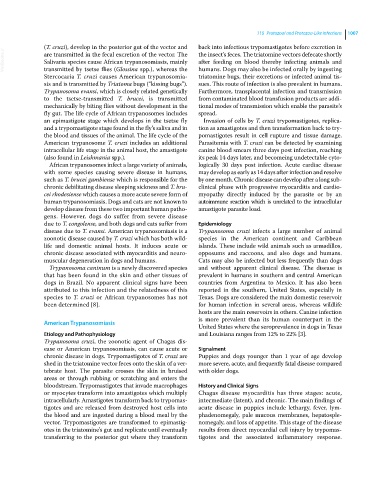Page 1069 - Clinical Small Animal Internal Medicine
P. 1069
110 Protozoal and Protozoa‐Like Infections 1007
(T. cruzi), develop in the posterior gut of the vector and back into infectious trypomastigotes before excretion in
VetBooks.ir are transmitted in the fecal excretion of the vector. The the insect’s feces. The triatomine vectors defecate shortly
after feeding on blood thereby infecting animals and
Salivaria species cause African trypanosomiasis, mainly
transmitted by tsetse flies (Glossina spp.), whereas the
triatomine bugs, their excretions or infected animal tis-
Stercocaria T. cruzi causes American trypanosomia- humans. Dogs may also be infected orally by ingesting
sis and is transmitted by Triatoma bugs (“kissing bugs”). sues. This route of infection is also prevalent in humans.
Trypanosoma evansi, which is closely related genetically Furthermore, transplacental infection and transmission
to the tsetse‐transmitted T. brucei, is transmitted from contaminated blood transfusion products are addi-
mechanically by biting flies without development in the tional modes of transmission which enable the parasite’s
fly gut. The life cycle of African trypanosomes includes spread.
an epimastigote stage which develops in the tsetse fly Invasion of cells by T. cruzi trypomastigotes, replica-
and a trypomastigote stage found in the fly’s saliva and in tion as amastigotes and then transformation back to try-
the blood and tissues of the animal. The life cycle of the pomastigotes result in cell rupture and tissue damage.
American trypanosome T. cruzi includes an additional Parasitemia with T. cruzi can be detected by examining
intracellular life stage in the animal host, the amastigote canine blood smears three days post infection, reaching
(also found in Leishmania spp.). its peak 14 days later, and becomeing undetectable cyto-
African trypanosomes infect a large variety of animals, logically 30 days post infection. Acute cardiac disease
with some species causing severe disease in humans, may develop as early as 14 days after infection and resolve
such as T. brucei gambiense which is responsible for the by one month. Chronic disease can develop after a long sub-
chronic debilitating disease sleeping sickness and T. bru- clinical phase with progressive myocarditis and cardio-
cei rhodesiense which causes a more acute severe form of myopathy directly induced by the parasite or by an
human trypanosomiasis. Dogs and cats are not known to autoimmune reaction which is unrelated to the intracellular
develop disease from these two important human patho- amastigote parasite load.
gens. However, dogs do suffer from severe disease
due to T. congolense, and both dogs and cats suffer from Epidemiology
disease due to T. evansi. American trypanosomiasis is a Trypanosoma cruzi infects a large number of animal
zoonotic disease caused by T. cruzi which has both wild- species in the American continent and Caribbean
life and domestic animal hosts. It induces acute or islands. These include wild animals such as armadillos,
chronic disease associated with myocarditis and neuro- opposums and raccoons, and also dogs and humans.
muscular degeneration in dogs and humans. Cats may also be infected but less frequently than dogs
Trypanosoma caninum is a newly discovered species and without apparent clinical disease. The disease is
that has been found in the skin and other tissues of prevalent in humans in southern and central American
dogs in Brazil. No apparent clinical signs have been countries from Argentina to Mexico. It has also been
attributed to this infection and the relatedness of this reported in the southern, United States, especially in
species to T. cruzi or African trypanosomes has not Texas. Dogs are considered the main domestic reservoir
been determined [8]. for human infection in several areas, whereas wildlife
hosts are the main reservoirs in others. Canine infection
is more prevalent than its human counterpart in the
American Trypanosomiasis
United States where the seroprevalence in dogs in Texas
Etiology and Pathophysiology and Louisiana ranges from 12% to 22% [3].
Trypanosoma cruzi, the zoonotic agent of Chagas dis-
ease or American trypanosomiasis, can cause acute or Signalment
chronic disease in dogs. Trypomastigotes of T. cruzi are Puppies and dogs younger than 1 year of age develop
shed in the triatomine vector feces onto the skin of a ver- more severe, acute, and frequently fatal disease compared
tebrate host. The parasite crosses the skin in bruised with older dogs.
areas or through rubbing or scratching and enters the
bloodstream. Trypomastigotes that invade macrophages History and Clinical Signs
or myocytes transform into amastigotes which multiply Chagas disease myocarditis has three stages: acute,
intracellularly. Amastigotes transform back to trypomas- intermediate (latent), and chronic. The main findings of
tigotes and are released from destroyed host cells into acute disease in puppies include lethargy, fever, lym-
the blood and are ingested during a blood meal by the phadenomegaly, pale mucous membranes, hepatosple-
vector. Trypomastigotes are transformed to epimastig- nomegaly, and loss of appetite. This stage of the disease
otes in the triatomine’s gut and replicate until eventually results from direct myocardial cell injury by trypomas-
transferring to the posterior gut where they transform tigotes and the associated inflammatory response.

